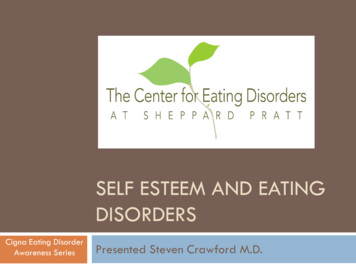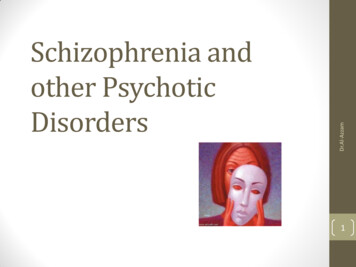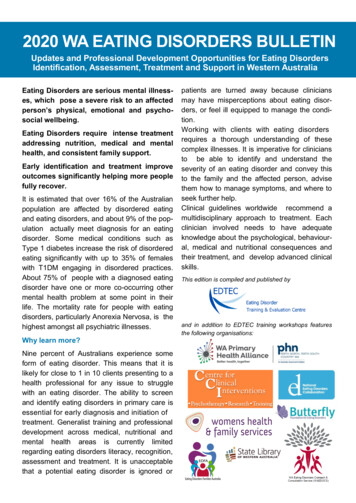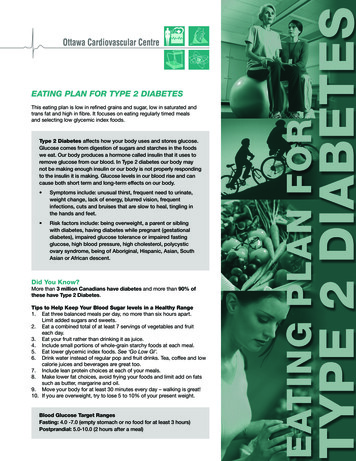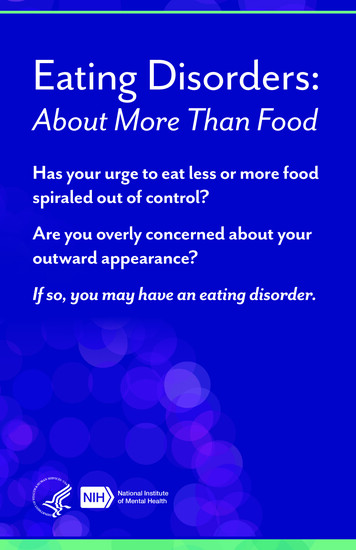
Transcription
Eating Disorders:About More Than FoodHas your urge to eat less or more foodspiraled out of control?Are you overly concerned about youroutward appearance?If so, you may have an eating disorder.National Instituteof Mental Health
What are eating disorders?Eating disorders are serious medical illnesses marked by severe disturbances to a person’s eatingbehaviors. Obsessions with food, body weight, and shape may be signs of an eating disorder.These disorders can affect a person’s physical and mental health; in some cases, they can belife-threatening. But eating disorders can be treated. Learning more about them can help youspot the warning signs and seek treatment early.Remember: Eating disorders are not a lifestyle choice. They are biologically-influencedmedical illnesses.Who is at risk for eating disorders?Eating disorders can affect people of all ages, racial/ethnic backgrounds, body weights, andgenders. Although eating disorders often appear during the teen years or young adulthood, theymay also develop during childhood or later in life (40 years and older).Remember: People with eating disorders may appear healthy, yet be extremely ill.The exact cause of eating disorders is not fully understood, but research suggests a combinationof genetic, biological, behavioral, psychological, and social factors can raise a person’s risk.What are the common types of eating disorders?Common eating disorders include anorexia nervosa, bulimia nervosa, and binge-eatingdisorder. If you or someone you know experiences the symptoms listed below, it could be a signof an eating disorder—call a health provider right away for help.What is anorexia nervosa?People with anorexia nervosa avoid food, severely restrict food, or eat very small quantities ofonly certain foods. Even when they are dangerously underweight, they may see themselves asoverweight. They may also weigh themselves repeatedly.There are two subtypes of anorexia nervosa: a restrictive subtype and binge-purge subtype.Restrictive: People with the restrictive subtype of anorexia nervosa place severe restrictions onthe amount and type of food they consume.Binge-Purge: People with the binge-purge subtype of anorexia nervosa also place severerestrictions on the amount and type of food they consume. In addition, they may have bingeeating and purging behaviors (such as vomiting, use of laxatives and diuretics, etc.).Symptoms include: Extremely restricted eating and/or intensive and excessive exercise Extreme thinness (emaciation) A relentless pursuit of thinness and unwillingness to maintain a normal or healthy weight Intense fear of gaining weight Distorted body image, a self-esteem that is heavily influenced by perceptions of body weightand shape, or a denial of the seriousness of low body weightOver time, these symptoms may also develop: Thinning of the bones (osteopenia or osteoporosis) Mild anemia and muscle wasting and weakness
Brittle hair and nails Dry and yellowish skin Growth of fine hair all over the body (lanugo) Severe constipation Low blood pressure, slowed breathing and pulse Damage to the structure and function of the heart Drop in internal body temperature, causing a person to feel cold all the time Lethargy, sluggishness, or feeling tired all the time Infertility Brain damage Multiorgan failureAnorexia can be fatal. Anorexia nervosa has the highest mortality (death) rate of any mental disorder.People with anorexia may die from medical conditions and complications associated with starvation; bycomparison, people with others eating disorders die of suicide.If you or someone you know is in crisis and needs immediate help, call the toll-free NationalSuicide Prevention Lifeline (NSPL) at 1–800–273–TALK (8255), 24 hours a day, 7 days a week.What is bulimia nervosa?People with bulimia nervosa have recurrent episodes of eating unusually large amounts of food and feelinga lack of control over these episodes. This binge-eating is followed by behaviors that compensate for theovereating, such as forced vomiting, excessive use of laxatives or diuretics, fasting, excessive exercise, or acombination of these behaviors. Unlike those with anorexia nervosa, people with bulimia nervosa maymaintain a normal weight or be overweight.Symptoms include: Chronically inflamed and sore throat Swollen salivary glands in the neck and jaw area Worn tooth enamel and increasingly sensitive and decaying teeth (a result of exposure to stomach acid) Acid reflux disorder and other gastrointestinal problems Intestinal distress and irritation from laxative abuse Severe dehydration from purging Electrolyte imbalance (too low or too high levels of sodium, calcium, potassium and other minerals),which can lead to stroke or heart attackWhat is binge-eating disorder?People with binge-eating disorder lose control over their eating. Unlike bulimia nervosa, periods ofbinge-eating are not followed by purging, excessive exercise, or fasting. As a result, people with bingeeating disorder are often overweight or obese.Symptoms include: Eating unusually large amounts of food in a specific amount of time, such as a 2-hour period Eating fast during binge episodes
Eating even when full or not hungry Eating until uncomfortably full Eating alone or in secret to avoid embarrassment Feeling distressed, ashamed, or guilty about eating Frequently dieting, possibly without weight lossHow are eating disorders treated?It is important to seek treatment early for eating disorders. People with eating disorders are at higher riskfor suicide and medical complications. Some people with eating disorders may also have other mentaldisorders (such as depression or anxiety) or problems with substance use.Treatment plans for eating disorders include psychotherapy, medical care and monitoring, nutritionalcounseling, medications, or a combination of these approaches. Typical treatment goals include restoringadequate nutrition, bringing weight to a healthy level, reducing excessive exercise, and stopping bingepurge and binge-eating behaviors. Complete recovery is possible.Specific forms of psychotherapy (or “talk therapy”) and cognitive behavioral approaches can be effectivefor treating specific eating disorders. For more about psychotherapies, visit ex.shtml.Research also suggests that medications may help treat some eating disorders and co-occurring anxiety ordepression related to eating disorders. Information about medications changes frequently, so talk to yourhealth care professional and check the U.S. Food and Drug Administration (FDA) website for the latestwarnings, patient medication guides, or newly approved medications.How Do I Find Treatment?The NIMH is a federal research agency and cannot provide medical advice or practitionerreferrals. However, there are tools and resources available at www.nimh.nih.gov/findhelpthat may help you find a provider or treatment.How is NIMH addressing eating disorders?The National Institute of Mental Health (NIMH) is conducting and supporting research that could helpfind new and improved ways to diagnose and treat eating disorders. For example, the NIMH EatingDisorders Research Program supports research on the causes, symptoms, diagnosis, and treatment atmedical institutions across the country. It also supports studies that can help explain the risk factors thatcause eating disorders to start or reoccur. The program’s studies on treatment help move basic sciencefindings from the lab bench to a patient’s bedside.What are some examples of NIMH research?Eating disorders tend to run in families, so one example of NIMH-supported research involves the studyof human genetics. Researchers are working to identify DNA variations that are linked to an increased riskof developing eating disorders. This research may help develop strategies for early detection.Brain imaging studies are also providing a better understanding of eating disorders. For example,researchers have found differences in patterns of brain neurocircuitry and activity in people with eatingdisorders in comparison with healthy people. This research may lead to new or improved ways todiagnose and treat eating disorders.
How can I participate in research?Clinical research is medical research that involves people like you. People volunteer toparticipate in carefully conducted investigations that ultimately uncover better ways to treat,prevent, diagnose, and understand human disease. Clinical research includes clinical researchtrials that test new treatments and therapies as well as long-term natural history studies, whichprovide valuable information about how disease and health progress.Please Note: Decisions about participating in a clinical trial and determining which onesare right for you are best made in collaboration with your licensed health professional.How do I find a clinical trial?Researchers at NIMH conduct clinical trials on numerous areas of study, including cognition,genetics, epidemiology, and psychiatry. These clinical trials take place at the NIH Clinical Centerin Bethesda, Maryland, and may require regular visits. After an initial phone interview, you willcome to an appointment at the clinic and meet with a clinician. Visit the NIMH Clinical Trials— Participants or Join a Study pages for more information on participating in clinical trials.To find a clinical trial near you, you can visit www.ClinicalTrials.gov. This website is asearchable registry and results database of federally and privately supported clinical trialsconducted in the United States and around the world. ClinicalTrials.gov gives you informationabout a trial’s purpose, who may participate, locations, and phone numbers for more details.This information should be used in conjunction with advice from health professionals.Where Can I Find Help?Mental Health Treatment LocatorFor more information, resources, and research on mental illnesses, visit the NIMH website atwww.nimh.nih.gov. The National Library of Medicine’s MedlinePlus website (medlineplus.gov/)also has information on a wide variety of mental disorders.For general information on mental health and to locate treatment services, call the SubstanceAbuse and Mental Health Services Administration (SAMHSA) Treatment Referral Helplineat 1–800–662–HELP (4357). SAMHSA also has a Behavioral Health Treatment Locator on itswebsite (findtreatment.samhsa.gov) that can be searched by location.Questions to Ask Your DoctorAsking questions and providing information to your doctor or health care provider can improveyour care. Talking with your doctor builds trust and leads to better results, quality, safety,and satisfaction. Visit the Agency for Healthcare Research and Quality website for tips atwww.ahrq.gov/patients-consumers.More information about finding a health care provider or treatment for mental disorders isavailable on our Finding Help for Mental Illness webpage, available at www.nimh.nih.gov/findhelp.
ReprintsThis publication is in the public domain and may be reproduced or copied without permission from NIMH.We encourage you to reproduce it and use it in your efforts to improve public health. Citation of NIMH as asource is appreciated. However, using government materials inappropriately can raise legal or ethicalconcerns, so we ask you to use these guidelines: NIMH does not endorse or recommend any commercial products, processes, or services, and ourpublications may not be used for advertising or endorsement purposes. NIMH does not provide specific medical advice or treatment recommendations or referrals; ourmaterials may not be used in a manner that has the appearance of providing such information. NIMH requests that non-Federal organizations not alter our publications in ways that will jeopardize theintegrity and “brand” when using the publication. The addition of non-Federal Government logos and website links may not have the appearance of NIMHendorsement of any specific commercial products or services, or medical treatments or services. Images used in publications are of models and are used for illustrative purposes only. Use of someimages is restricted.If you have questions regarding these guidelines and use of NIMH publications, please contact the NIMHInformation Resource Center at 1–866–615–6464 or email nimhinfo@nih.gov.Where Can I Find More Information?To learn more about eating disorders, visit:MedlinePlus (National Library of Medicine) (En Español)For information on clinical trials, visit:ClinicalTrials.govFor more information on conditions that affect mental health, resources, and research, goto MentalHealth.gov, the NIMH website, or contact us at:National Institute of Mental HealthOffice of Science Policy, Planning, and CommunicationsScience Writing, Press, and Dissemination Branch6001 Executive BoulevardRoom 6200, MSC 9663Bethesda, MD 20892-9663Phone: 301–443–4513 or 1–866–615–NIMH (6464) toll-freeTTY: 301–443–8431 or 1–866–415–8051 toll-freeFAX: 301–443–4279Email: nimhinfo@nih.govWebsite: www.nimh.nih.govNational Instituteof Mental HealthU.S. Department of Health and Human ServicesNational Institutes of HealthNIH Publication No. TR 17-4901Revised 2018
also has information on a wide variety of mental disorders. For general information on mental health and to locate treatment services, call the . Substance Abuse and Mental Health Services Administration (SAMHSA) Treatment Referral Helpline. at 1 – 800 – 662 – HELP (4357). SAMHSA also has a Behavioral
